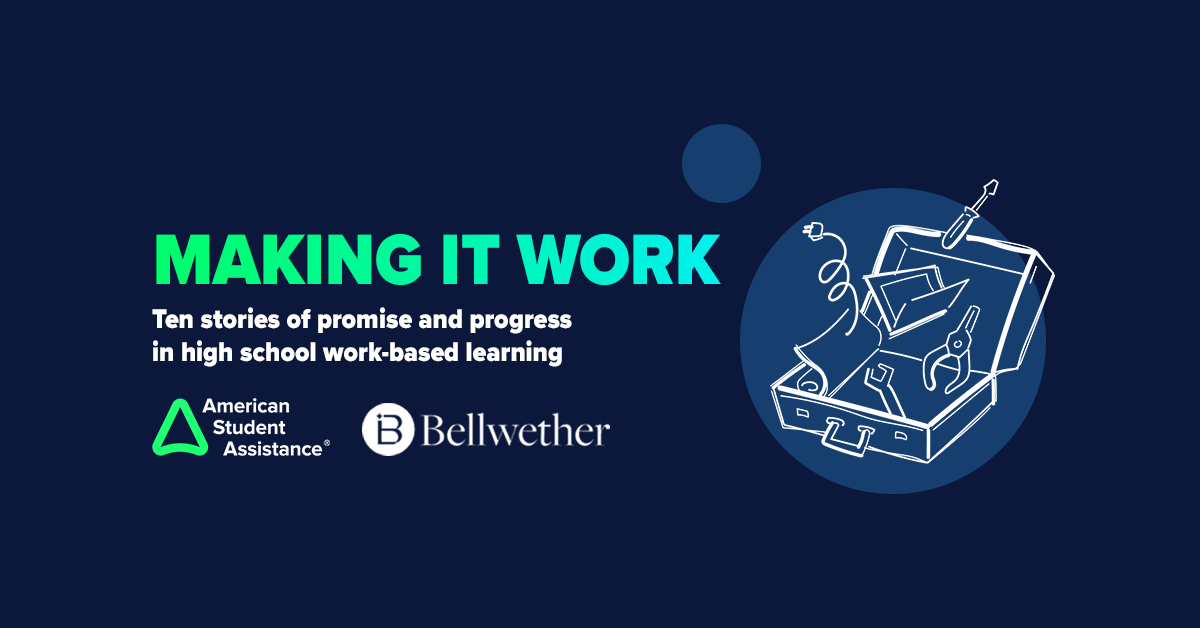Since the publication of our Working to Learn report, we at ASA have been digging deeper into best practices and policies employed by states to expand and improve high school work-based learning programs. We recently spoke with representatives in Delaware about their success with the Pathways program; you can read Parts 1 and 2 here. In this next installment, we chat with Dr. Kerry Akashian, Career Development Education Lead at the Massachusetts Department of Elementary and Secondary Education.
Since the publication of our Working to Learn report, we at ASA have been digging deeper into best practices and policies employed by states to expand and improve high school work-based learning programs. We recently spoke with representatives in Delaware about their success with the Pathways program; you can read Parts 1 and 2 here. In this next installment, we chat with Dr. Kerry Akashian, Career Development Education Lead at the Massachusetts Department of Elementary and Secondary Education.
Q: Career-focused education has become a more prominent focus for many states in recent years, but here in Massachusetts, it’s been a priority for much longer. Can you walk us through the history and how it works here in the Commonwealth?
Kerry: Career development in Massachusetts is a collaboration among partners in K-12 education, higher education, workforce development and other youth-serving agencies. Multiple programs and initiatives deliver these learning opportunities to youth, from Career/Vocational Technical Education to Innovation Pathways to MYCAP (My Career and Education Plan). One of the longest running programs, since 1998, is Connecting Activities, a statewide network led by the Massachusetts Department of Elementary and Secondary Education. It’s an intermediary group who works with the MassHire Workforce Boards, and the reason why the Department of Education is involved is because of our youth focus, so instead of having the Department of Labor and Workforce Development lead these initiatives, it’s the Department of Education alongside the Department of Labor and Workforce Development. The youth leads at the regional workforce boards serve as intermediaries and liaisons with schools and employers to increase the number of high-quality internship opportunities to ensure that students are getting equitable career development education experiences and are growing the future workforce in Massachusetts.
Q: How has COVID impacted your efforts around work-based learning?
Kerry: Last year a lot of students all across the country floundered during the pandemic and youth employment was one way to keep kids safe and productive, so there’s been an increased engagement and excitement around work-based learning.
Pre-COVID, Connecting Activities would typically have one convening a year and then one leadership meeting. But with the rise of new ways to connect virtually during the pandemic, we were able to meet much more frequently to develop quality programming. Our Zoom check-ins turned into a sharing of practices statewide. I think in 2020 we had about 17 meetings and this year we’re coming up on over 20.
The pandemic also sparked an innovative program this year, where the workforce development boards, through the Connecting Activities grant and through federal funding, employed 800 high school seniors to work at K-8 schools as tutors to help accelerate the learning of the students and to support teachers. So, the students benefitted from work-based learning experiences and were paid for their work, they contributed to their community, and they received professional development from a group called Educators Rising. It was a wonderful project that had never been done before, and something that other states might be interested in. It’s a concrete example of how the intermediaries at the workforce boards worked with schools, placed the kids on the payroll quickly, and in turn provided for the communities.
Q: Were there other innovations during the pandemic?
Kerry: Yes, career development just has been so much more accessible, both for students and adults. YouthWorks, a state-funded youth employment program, is like a sister group to Connecting Activities. Where we are charged with helping schools and employers, they actually support the students with professional development, subsidized stipends and different types of payments for underserved youth. During the pandemic, they developed a lot of virtual work-based learning projects for companies and more students were able to participate than in previous years. Another example of how the virtual environment really supported us is a speaker series in our Cape & Islands region. It used to be just face-to-face but was moved to Zoom, and so representatives from the entire state were able to participate.
Q: Switching gears a bit, Massachusetts is one of the few states to have a line item in the state budget dedicated to work-based learning. What kind of an impact has that had?
Kerry: It’s had a really big impact in terms of signaling that the state is committed to this work. Massachusetts also has an employer wage match requirement, so Connecting Activities leaders are required to recruit employers that will actually pay the students and bring more funding into the system. Sometimes the money supplied by the employers can be four times the actual budget line item.
Stay tuned for Part 2 of our discussion to learn more about the Innovation Pathways program and how the Commonwealth has solved for some of the biggest barriers to work-based learning expansion.




